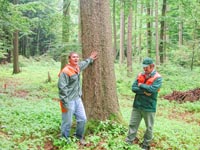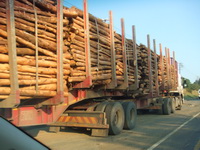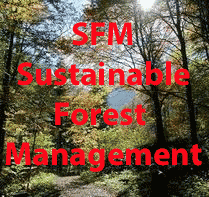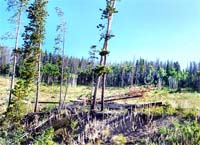Sustainable Forest Management - a principle developed in Central Europe
SUSTAINABLE FORESTRY - A HANDED DOWN PRINCIPLE MAKES WORLD CAREER
|
|
| Watch a video about our experience |
Developed at the beginning of the 18th century in Austria, Germany and Switzerland, the term sustainability nowadays describes the global task to protect the natural bases of life for following generations, thereby at the same time securing prosperity and social progress without obstructing the economic growth.
As long as the supply lasts - with this carefree attitude humans availed themselves of past times in the forests. They always struck wood where and whenever it was necessary and possible. And they needed a quantity of it: wood for building, for heating and for the production of utensils. Into the 18th and 19th century wood was the raw material number one. The thoughtless wood felling did not remain without consequences. At the beginning of the industrialization the domestic forest was in bad shape. Clear-felling and devastation of large areas were the harbingers of an alarming wood scarce which threatened the society at that time in its existence. Something had to happen. Without a fundamental reconstruction of the forests a further wood use to secure the basic necessities and the social progress was hardly conceivable. The task of the 19th century consisted of afforestation of all felled areas again - this time sustainably.
Sustainability begins to determine forest-economical way of acting
To immediately afforest each felled forest area again to keep the total forest portion constant - this so-called surface sustainability marks the beginning of the development of the forest-economical basic law.
Sustainability means in the sense of word continuation, stability, return, steadiness or continuous effect. The term and thought 'sustainability' is already on record in Central Eurpope since the 16th century. The term was for the first time published and used in 1713 by the Saxonian mountain captain H. C von Carlowitz in its book "Sylvicultura Oeconomica", silviculture and economics. Around hundred years later, George Ludwig Hartig in its writing "instruction for the rating and description of the forests" provides the following definition of sustainability.
Each wise forest directorate must let tax the woodlands (…) without time delay, and tax it as highly as possible, but seek to use it in such a way that descendants can draw at least just as much advantage from it as the currently living generation.
Today the forest-economical principle of the sustainability means the fact that only as much wood is used as durably can be regenerated and that forests are managed in such a way that soil, animal and plant world remain intact. Apart from the utilizable function of the forest the functions protection and recovery are also considered. Thus it is ensured that the forest remains a natural habitat and, at the same time, remains usable for the public welfare - with view of the future in the sense of the generation contract.
Sustainability as postulate for all local and global activities
Even as the term of the sustainability continued to develop in the course of the time and is understood today in an extended ecological, economic and social sense, the words of Carlowitz and Hartigs have not lost their validity and topicality.
The commission for environment and development of the United Nations under the presidency of the Prime Minister of Norway, Gro Harlem Brundtland submitted its report in 1987. Therein it is written:
"A sustainable future-compatible development corresponds to the needs of today's generation, without endangering the possibilities of future generations of satisfying their own needs and of protecting their life-style.
This concept became the worldwide valid mission statement at the UN environment conference of 1992 in Rio de Janeiro. The signatory states decided to work toward the fact that the needs of present and future generations on development and environment are fairly fulfilled.
Emerging from Austria, Germany and Switzerland the principle of sustainability is today recognized in all parts of the world as principle of an arranged and well-planned forestry. The over two hundred year old goal of using forests sustainably is - at least in many parts of Europe - achieved and the current practice of forest-economical management. The European conference of ministers in Lisbon specified in 1998 the criteria, indicators and guidelines for the sustainable wood culture with state-extending validity. Therein the yardsticks become recognizable on which forestry must be based worldwide.
Wood offers an incomparably favorable energy balance, in particular, as a building material if it arrives from domestic production without long routes of transportation into the processing industry.
TIMBER - RAW MATERIAL WITHOUT ORIGIN?
Opinions to forest, forestry and timber. Scientists of the Technical University of Munich expose phantom worlds in the public perception
What do you perceive if you think of the forest? Most humans would probably begin this question by describing a more or less sentimental picture: forest is nature, a valuable ecological system important for life. It serves as the life basis for a variety of animal and plant types, serves humans as recreation area for spare time and vacation. Forests are green lungs and protect the climate. In addition, forests are also experienced as something threatened: clear-felling, forest dying, storm damages - everywhere dangers, all reasons to be concerned of. Therefore, the ecological system forest requires special protection.
If it concerns the topic forest, an emotional feelings obviously outweighs. The concept of the forest functions represented by the forest economy - the triad of the protection, recovery and usage functions absolutely necessary for the conservation of the ecological system - is not reflected in such a way in the collective picture the population has from the forest.
If the society thinks of timber, people make the first association with wood products, furniture, parquet or other products for the life and housing requirement. Throughout positive attributes are attributed to timber, like "is natural, radiates warmth, smells pleasantly, creates coziness". Similarly as with the keyword forest, the perception is of emotional nature. If the natural product timber is mentally associated with forest as a nature area, the described, emotionally coined forest associations begin. Forestry and its task to make the raw material timber available by forest management are mentally disregarded.
The term forestry has rather a relation to forests than to timber in the public perception. In this relation the perception of the forest as protection-needy and protection-worthy ecological system moves into the foreground. The forest management is in direct confrontation of this association. Forest management and forest endangerment seem to be related in the perception. From this, a critical basic attitude to forest-economical activities results.
Thus, an acceptance gap can be recognized. Everyone would like a parquet floor, but - please - trees are not to be felled. The function of forestry as link between forest and timber(-product) hardly plays a role in the perception. It shows up as a phenomenon comparable to the "slaughter house paradox": The cattle on the pasture, the steak on the plate are positively evaluated. Unavoidable slaughtering causes however negative associations or is mentally not perceived at all.
Forestry therefore appears in a rather negatively colored light, so that the majority considers it appropriate to maintain certain skepticism. This assessment logically also shapes the opinion about the forest-economical principle of the sustainability - of which virtually everyone believes to know what it means. Doubts exist however whether it is actually always and everywhere maintained. Doubts, which stem less from an objectively critical attitude to forestry, but rather have their roots in the irrational concern about the allegedly threatened forest reserve.
The prevailing opinions to forest, forestry and timber mainly reduce these topics with their complex connections to partial aspects. None of the opinions and perceptions coincides with the reality. Forest is not only a protection-needy ecological system, forestry is not only forest management, and the raw material timber has indeed an origin and a producer.
The phantom worlds in the minds are opposed by the reality with clear facts: The use of the raw material timber by domestic forestry takes place without reservation according to the principle of the sustainability. Severity legal editions in the federal forest law and the national forest laws ensure the fact that only as much wood is used as durably regenerates. The management is done according to integral principles which also include environment protection and protection of species. The active rejuvenation and afforestation of the forest reserve are part of these efforts. Besides, with the certification by independent institutions the forestry has now an instrument with which the incontestable proof can be led that sustainability is implemented according to basic economic, ecological and social criteria.
From forest endangerment by forest management can thus not be spoken of - quite the opposite is true: Since 1960 the total forest surface of Austria increased by approximately 300,000 hectares. Since the beginning of regulated forestry more than two hundred years ago, the condition of the forest is today better than ever before. The present annual felling of 18 - 20 million cubic meters face currently a potential, annual increment of 30 million cubic meter. The felling potential is therefore used by only 70 per cent. In other words: The increase of the timber reserves exceeds the timber use.
The Austrian wood and forest lover can thus leave their phantom worlds and turn to the reality as far as forests are concerned. Then they will recognize that the supply of the raw material timber takes place via the forestry prudently and in a well-planned manner: the acceptance gap can be closed with a good conscience. Without forest management and timber use a forest, which fulfills also its social and ecological functions, is not conceivable.
ENTERPRISE FORESTRY - SUSTAINABILITY LOCALLY
Modern forest management fulfills the complex task to protect and sustain the multi-functional importance of the forest. This task gets also input from economic, ecological and social components.
The domestic forest plays an important role as economy factor and employer in the rural area. Altogether Austrian forest sector achieves a production value of annually approx. 10 billion € (Euro); approximately 250,000 humans find occupation in this sector. De facto, the income of the forest owners is based by 90 per cent on the sustainable use of the forest as a raw material supplier. From the timber revenue the expenditures, which are necessary to maintain the protection and recreation functions of the forest, must be financed.
Economic activities in and with nature
It is sustainable goal and lived practice by the forest owners to develop and nurture nature-near, species-rich and sturdy forests from locally suitable tree species. They make use of the natural sequences and self-control mechanisms of the forest-ecological system. In this sense forest management, afforestation and forest maintenance means to intervene with well-planned forestry measures in such places where it is necessary and meaningful.
Planned felling is therefore an important forest care measure, which also offers effect of timber use. In order to promote vitality and quality, trees are regularly taken out from the forest stand. Besides, the planned felling can favour competition-weaker tree species that, for example, support the structure of a sturdy mixed forest. The timber cut by planned felling is, for instance, used in the paper industry or for the production of splinter and fibreboards. Thus it is a not less valuable raw material than the log and source of income for the forest owners.
Controlling of natural processes
For the durable conservation of intact and yield-safe forests, the forest owners promote the natural rejuvenation in old forest stand. Trees, which have achieved their use age, are purposefully taken out, so that an optimal quantity of light, warmth and precipitation can reach the forest soil and the young trees receive ideal growth conditions. Apart from the care of the regenerating tree generation, forest-economically prudent acting also means to leave a certain portion of death wood in a forest stand to maintain the base of life for a multiplicity of animal species. The forestry measures of the forest owners always cover the forest in a whole area so that the organization of forest edges is also included. Sturdy forest edges protect against extreme weather conditions and offer living space and food for numerous animal and plant types.
Thus the forest owners altogether implement with their responsible controlling of natural processes not only important aspects of the nature-near forest management but also make a valuable contribution to the nature protection.
Not like the axe in the forest
Careful handling of the forest eco-system shapes the way in which the timber harvest and transportation of the timber are carried out in the enterprise forestry. In order to avoid having the harvesting machines drive into the forest stand, the creation of logging paths are operative measures. The sensitive forest soil is also protected by the use of modern machines, which are equipped with broad tires and thus cause small pressure point load. At the same time the forest paths open the forest for people looking for recreation and thus contribute to make this nature experience available to millions of people.
In the synopsis of all factors of which the complex management task of the forest owners consists, one thing shows up clearly: compared to other industries the forestry must face a whole set of specific challenges. In no other industry, the production process extends over decades. Trees that are ready to be harvested today were often planted one hundred or more years ago. Therefore, a fundamental conversion of production and its conditions can never be realized at short notice in the forest enterprise. The tree is "machine" and product at the same time. The wood growing annually on each individual tree in form of a year ring can be harvested only in form of whole trees in an appropriate quantity. This quantity has to be determined based on divergent parameters and calculation fundamentals. And we must not forget: It is always "day of the open door" in the enterprise forestry - around the clock, year by year. With private forest ownership taking up >80% of the forest area in Austria, this fact is not a foregone conclusion. Thus, the enterprise forestry carries an economic, ecological and social responsibility, which can hardly be compared with the one of other industries.
In view of the multi-layered tasks in the forestry practice, inventory systems provide help to secure the management of the forest beyond decades. Together with the data of the soil condition and forest damage survey, the stocktaking results supply important indicators for ongoing control and monitoring of our forests.








